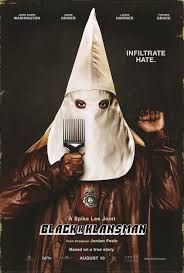BlacKkKlansman
Posted on August 9, 2018 at 5:24 pm
A-| Lowest Recommended Age: | High School |
| MPAA Rating: | Not rated |
| Profanity: | Very strong and racist language |
| Alcohol/ Drugs: | Alcohol |
| Violence/ Scariness: | Peril and violence |
| Diversity Issues: | A theme of the movie |
| Date Released to Theaters: | August 10, 2018 |
| Date Released to DVD: | November 5, 2018 |

Stallworth also really went undercover at a lecture by black activist Stokely Charmichael, who had just changed his name to Kwame Ture, and who is played here by Corey Hawkins, conveying Ture’s magnetism and fiery brilliance and making an impression so strong in his brief scene that it resonates throughout the rest of the film. This rally is really the pivotal, as Washington shows us as close unguarded as Stallworth gets, which opens him up to pursuing Patrice (Laura Harrier), a pretty activist he meets there. But of course he has to stay undercover with her, too — personally, not professionally — because she has strong political feelings about working within the system in general and about the police in particular. (This character and their relationship are fictional.) Adam Driver, as Stallworth’s white partner, has his own double-undercover moments. He thinks it does not matter that he is Jewish, but as Stallworth tells him, he has skin in the game, too. Near the end of the film, Stallworth is undercover at least two levels when he is assigned to Duke’s security detail and must stand close to the man who does not know Stallworth is the man he spoke to in confidence over the phone.
Law enforcement might have been an unusual choice for a black man of that era, but in every other respect Stallworth seems born to be in law enforcement, happy to accept the offer, and clearly aware of the challenges he will face, from the superiors who assign him safe but boring jobs to racist comments from some of the other officers. Washington (a former pro football player and regular on “Ballers”) projects an easy physical confidence, nerves of steel, and a personal meticulousness, from his perfectly shaped Afro to his neatly ironed shirt and shined shoes. Lee, working with production designer Curt Beech, costume designer Marci Rodgers, and director of photography Chayse Irvin, bring a light touch to a 70’s vibe that owes as much to the movies and pop culture of the era as to what ordinary people and settings looked like. There’s a nice nod to 70’s movies as well in the graphics and sinuous, jazzy camerawork and the way the handsome, athletic Washington is lit like Shaft or Superfly.
There could be no better depiction of what Hannah Arendt called “the banality of evil” than the Klansmen and women in this film, who chat casually about hatred and terrorism the way other small groups of like-minded communities might talk about an upcoming bake sale. We can almost sympathize with a 1970’s wife who just wants a chance to do something important like the men do or the men who get a sense of fellowship in a shared interest. Topher Grace shows us Duke’s silky, ingratiating manner, and Lee shows us that complacent hatred may be the most insidious.
It may seem to some viewers that an opening montage of racist imagery, including D.W. Griffith’s “Birth of a Nation” and a scene of Alec Baldwin as a racist businessman are over the top, until we see the footage from 2017’s white supremacist rally Charlottesville one year before the release of this film. Lee is one of my favorite directors, but he sometimes has more ideas than story or characters in his films. Here, with Stallworth’s remarkable true and timely story, a star-making performance by Washington, whose resemblance to his double Oscar-winning father is more in his voice than his face, he has made one of his all-time best, most purely entertaining, and most important films.
Parents should know that this film includes depictions of terrorist activities with peril and violence and very strong and offensive language. Characters drink alcohol.
Family discussion: How did Ron and Patrice differ in their ideas about the best way to solve problems and make things better? What has changed and what has not since the 1970’s?
If you like this, try: the book by Ron Stallworth and Lee’s films “Inside Man,” “School Daze,” and “Chi-Raq”
Recommended reviews: Odie Henderson on rogerebert.com, Travis Hopson on Punch Drunk Critics
